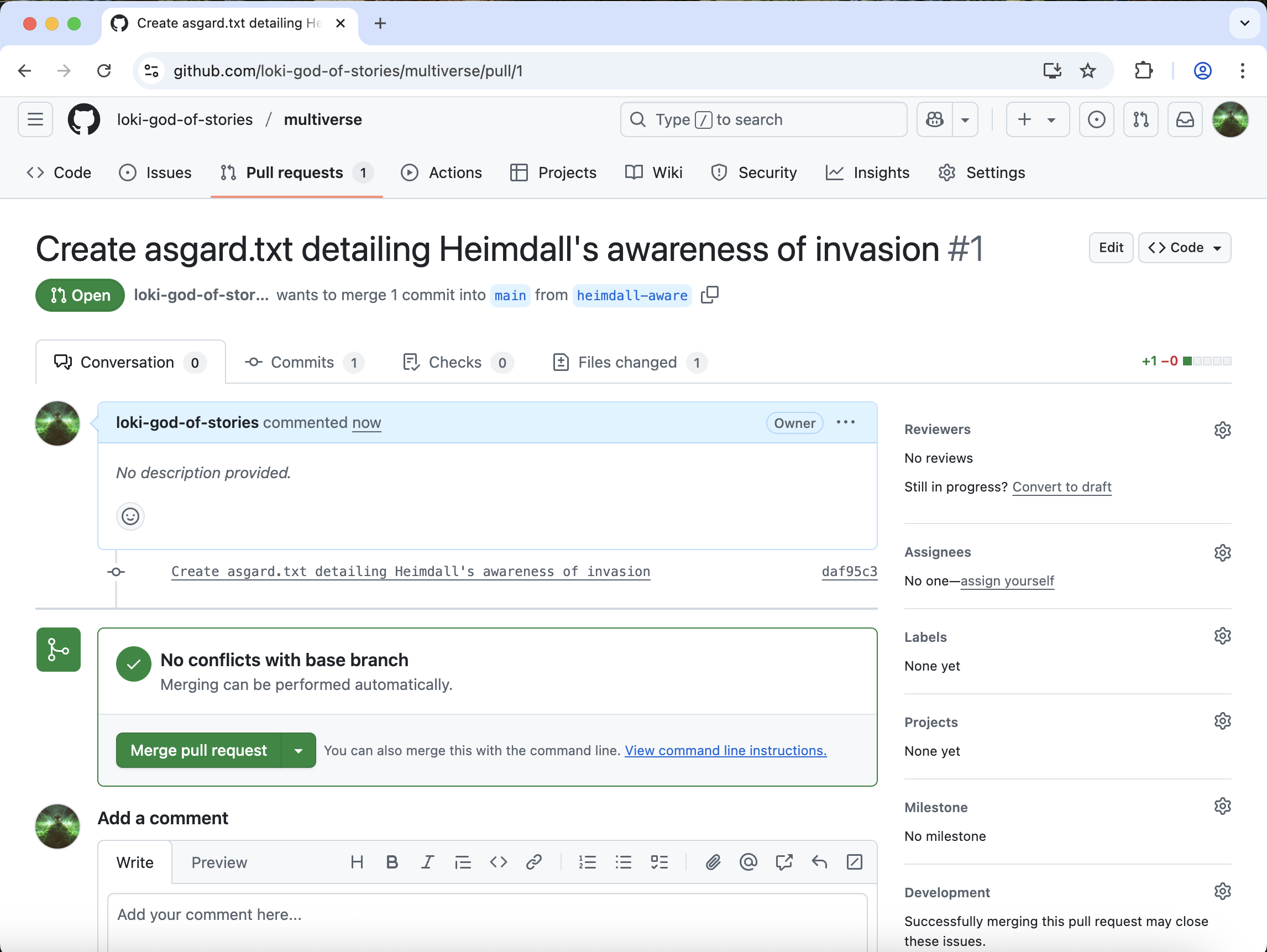Pull Requests
Last updated on 2025-05-23 | Edit this page
Overview
Questions
- What are pull requests for?
- How can I make a pull request?
Objectives
- Define the terms fork, clone, origin, remote, upstream
- Understand how to make a pull request and what they are useful for
Pull requests are a great way to collaborate with others using github. Instead of making changes directly to a repository you can suggest changes to a repo. This can be useful if you don’t have permission to modify a repository directly or you want someone else to review your changes.
On GitHub, in your multiverse repo, click on the
“Pull Requests” tab.
Then click “New pull request”. Alternatively, GitHub will see your new branch with recent changes and will prompt you to “Compare & pull request”. Click this button to also be taken to the new pull request page.

Make sure that the “base” branch is main and the
“compare” branch is heimdall-aware.
Next, we need to give our PR a title. By default, your PR will get the title from your last commit. We can leave this as is.
Click “Create pull request”.

Your multiverse repo should now have 1 pull request.
This is the phase where you would normally request a reviewer, who can
leave comments on your code. In repos that you do not own, your PR will
need to be approved by a codeowner before you can merge it. Since you
are the codeowner, we can go ahead and click “Merge pull
request”. Confirm & complete the merge.
Go back to the “Code” tab and make sure you are on the “main” branch. You should now see an “asgard.txt” file.
Let’s go back to VS Code. Checkout the main branch, and look at the files and history:
OUTPUT
2f2d364 (HEAD -> main, origin/main, origin/HEAD) Complete story with Thor-Jane reunion
ee67c8b Implement counterattack strategy
9b26458 Start story for New Asgard in earth.txt
f537d84 Initial commitThe analysis file is not on “main” yet. This is because we need to first pull the changes we made with the Pull Request from the remote repository.
OUTPUT
remote: Enumerating objects: 1, done.
remote: Counting objects: 100% (1/1), done.
remote: Total 1 (delta 0), reused 0 (delta 0), pack-reused 0 (from 0)
Unpacking objects: 100% (1/1), 952 bytes | 476.00 KiB/s, done.
From https://github.com/loki-god-of-stories/multiverse
2f2d364..976b48e main -> origin/main
Updating 2f2d364..976b48e
Fast-forward
asgard.txt | 1 +
1 file changed, 1 insertion(+)
create mode 100644 asgard.txt$ git log --onelineOUTPUT
976b48e (HEAD -> main, origin/main, origin/HEAD) Merge pull request #1 from loki-god-of-stories/heimdall-aware
daf95c3 (origin/heimdall-aware, heimdall-aware) Create asgard.txt detailing Heimdall's awareness of invasion
2f2d364 Complete story with Thor-Jane reunion
ee67c8b Implement counterattack strategy
9b26458 Start story for New Asgard in earth.txt
f537d84 Initial commitNow our main branch is up to date.
Deleting branches
Now that we’ve merged the heimdall-aware into
main, these changes exist in both branches. This could be
confusing in the future if we stumble upon the
heimdall-aware branch again.
We can delete our old branches so as to avoid this confusion later.
We can do so by adding the -d flag to the
git branch command.
OUTPUT
Deleted branch heimdall-aware (was daf95c3).And because we don’t want to keep the changes in the
heimdall-blind branch, we can delete the
heimdall-blind branch as well
OUTPUT
error: The branch 'heimdall-blind' is not fully merged.
If you are sure you want to delete it, run 'git branch -D heimdall-blind'.Since we’ve never merged the changes from the
heimdall-blind branch, git warns us about deleting them and
tells us to use the -D flag instead.
Since we really want to delete this branch we will go ahead and do so.
OUTPUT
Deleted branch heimdall-blind (was 59b9bab).Finally, we can also delete the heimdall-aware branch on
GitHub. Click on “Branches”, and to delete the
heimdall-aware branch click the trashcan
icon to the right of the branch name.
- Pull requests suggest changes to repos where you don’t have privileges
